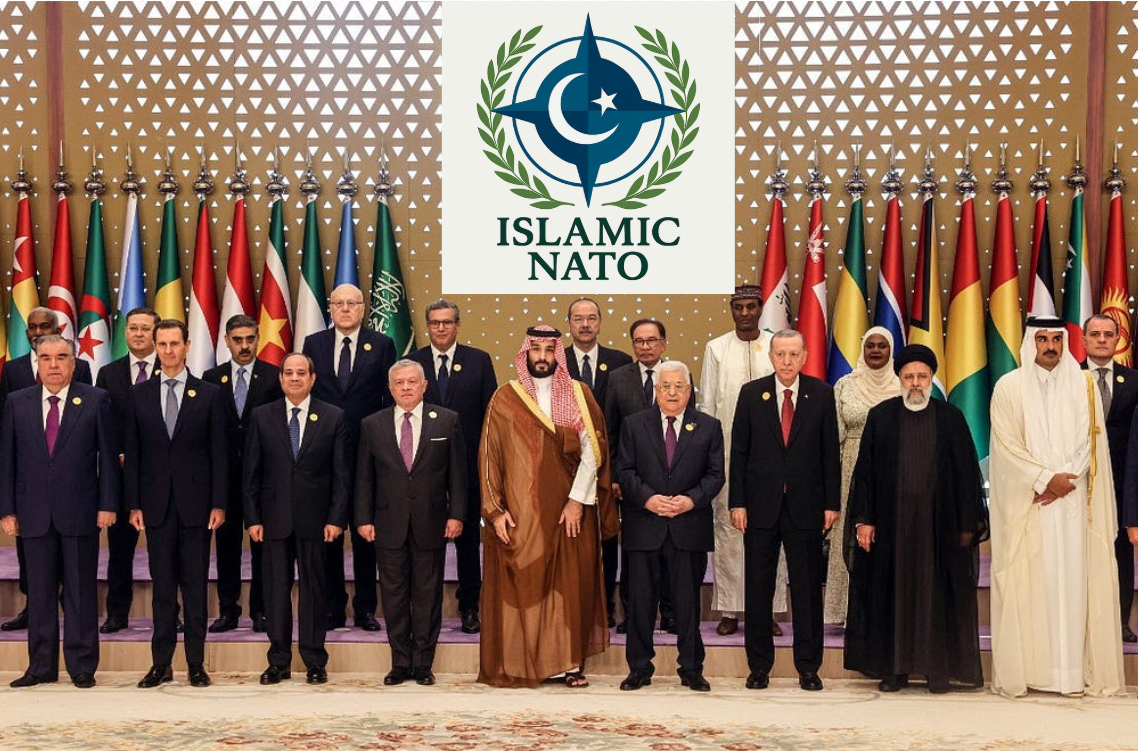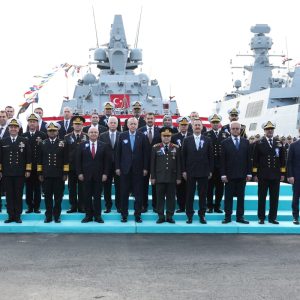In the wake of Israel’s September 9 air‑launched ballistic‑missile strike that targeted Hamas figures meeting in Doha, the Gulf’s security furniture is being rearranged in plain sight. The episode jolted assumptions about US guarantees and stoked debate over an Islamic NATO—or, more realistically, a “6+2” framework linking the six GCC states with Türkiye and Egypt [1][2][3]. While a formal Article 5‑style pact remains unlikely, the region is testing collective tools—shared warning, integrated air and missile defence, and coordinated exercises—that together can shift deterrence.
Key Facts
• Event: Israel conducts an over‑the‑horizon strike on Doha using air‑launched ballistic missiles (Sep 9, 2025) [1][4].
• GCC response: Emergency sessions affirm that an attack on one is an attack on all; defence ministers move to enhance intel‑sharing and early‑warning and to plan joint drills [5][6].
• New treaty: Saudi Arabia and Pakistan sign a Strategic Mutual Defense Agreement (Sep 17, 2025), raising questions about extended deterrence and a de facto nuclear umbrella [7][8][9].
• Working format: Analysts see a pragmatic “6+2” (GCC + Türkiye & Egypt) emerging—not a full Islamic NATO [3][10].
After Doha, a credibility shock
Qatar’s defences were not postured for a west‑originating, over‑the‑horizon ballistic profile. The strike exploited gaps in classification timelines and sensor geometry, a point underlined by open‑source analysis of the attack vector and US awareness—or lack thereof [1][4]. The shock was not simply technical. It was political: Washington’s posture is now read as conditional and transactional, prompting Gulf capitals to pursue redundancy in partnerships and sovereignty in warning and response.
That recalibration does not mean ejecting the United States. On the contrary, deeper integration of Gulf defence architectures typically increases reliance on US‑origin systems—sensors, shooters and command‑and‑control backbones. But the Islamic NATO conversation, even if aspirational, is the political wrapper for a harder technical push: common threat assessment, shared tracks, and distributed decision aids.
What a real alternative looks like
A NATO‑clone would bind states to fight for interests not their own and import all the problems of collective action. That is why regional experts argue the outcome will be more modular: capability pooling and policy coordination short of a treaty [3][10]. In practice, that could mean:
• GCC early‑warning federation. Accelerating a regional ballistic‑ and cruise‑missile warning grid with standardized message formats and cross‑cueing. The GCC has already signalled activation of its joint defence provisions and intent to fast‑track missile warning [5][6].
• 6+2 playbooks. Türkiye brings rapid‑deployment capacity and existing basing in Qatar; Egypt brings mass and logistics depth—albeit with reliability caveats. Shared playbooks can codify alert levels, air‑policing rotations, and maritime picket lines without a standing alliance staff [3].
• Exercise‑driven interoperability. Joint drills stress‑test the plumbing: link budgets, emissions control, IFF tables, and counter‑UAS TTPs. Done well, exercises create the muscle memory an Islamic NATO would claim, minus the treaty obligations.
Saudi–Pakistan pact: extended deterrence by another name?
Riyadh and Islamabad’s Strategic Mutual Defense Agreement declares that aggression against one is aggression against both. Officials downplay any nuclear dimension, but external observers note the obvious subtext given Pakistan’s nuclear status [7][8][9]. The pact formalizes decades of security intimacy and signals that Gulf deterrence hedges now extend beyond Western frameworks. For Israel and Iran, the message is that crisis calculus must account for Pakistani mass and Saudi resources—even if actual nuclear sharing remains off the table.
For Gulf planners, the Saudi–Pakistan axis complicates but can also complement a 6+2 approach. Pakistani officers and units are deeply familiar with Gulf terrain and militaries; Pakistani industry can augment training and certain sustainment pipelines. The risk is over‑interpreting the pact as a turnkey umbrella. Extended deterrence works when underwritten by credible, rehearsed conventional responses and tight political coordination—not by communiqué alone.
Deterrence signaling without Article 5
Post‑Doha, Gulf defence ministers agreed to enhance intelligence‑sharing and produce aerial situation reports, to fast‑track a regional ballistic‑missile warning system, and to plan joint exercises [6]. Those are unglamorous moves, but they are the essential substrate for deterrence. A would‑be attacker cares less about the name of an alliance and more about whether its launch will be detected, tracked, classified, and intercepted—and whether the political cost will compound across multiple capitals.
This is where a careful Islamic NATO narrative can help without over‑promising. The label communicates resolve to domestic audiences and signals cohesion to adversaries. The implementation should stay deliberately technical and incremental: federated radar data, common engagement zones, shared rules for cross‑border hot pursuit of non‑state actors, and harmonized crisis communications. Each step raises the bar for surprise attacks like Doha.
Industrial and C2 implications
A move toward 6+2‑style integration points to concrete programmes:
• Integrated air and missile defence (IAMD): Layered interceptors are only as good as their cueing. Expect investment in space‑based and high‑altitude sensing, hardened datalinks, and NATO‑style track management adapted to Gulf geography.
• Counter‑UAS mesh: Low‑cost, high‑volume threats demand shared tactics and inventory pooling—interceptors, jammers, and directed‑energy where feasible.
• Command‑and‑control (C2): A theatre‑level COP (common operating picture) that can fuse national feeds, with latency budgets and authority handoff defined in SOPs. This—more than rhetoric—is what will make any Islamic NATO credible.
• Exercises as acquisition: Use joint drills to validate vendor claims and to inform procurement—especially for warning networks and resilient PNT that survived jamming in recent conflicts.
The bottom line
An Islamic NATO is a catchy headline, not a near‑term treaty. Yet something real is taking shape: Gulf‑led, partner‑enabled security that prizes early warning, rapid coordination, and credible cross‑capital costs for aggression. If Doha was intended to show the region’s seams, it may instead become the forcing function for stitching together a more resilient patchwork.
Internal link
For standards‑driven integration issues, see our analysis of NATO’s updated sense‑and‑avoid rules for UAS—useful for airspace deconfliction in crowded theatres: https://defenceagenda.com/nato‑aep‑107‑sense‑and‑avoid‑uas/ [11]
External link
GCC statement on joint defence activation and support to Qatar: https://www.gcc-sg.org/en/MediaCenter/News/Pages/news2025-9-18-5.aspx [5]
References
[1] DW: “Is the Middle East about to get an Islamic NATO?” (analysis and reporting on post‑Doha dynamics).
[2] Al‑Monitor: “Pentagon had no warning Israel planned to strike Qatar.”
[3] ECFR / Cinzia Bianco commentary on a potential 6+2 format.
[4] The War Zone (TWZ): “New info on how U.S. military was caught off guard by Israeli strike on Qatar.”
[5] GCC Secretariat: Extraordinary Session statement affirming ‘attack on one is attack on all.’
[6] GCC follow‑up communiqués on intel‑sharing, aerial situation reports, joint drills, and missile‑warning acceleration.
[7] Reuters: “Saudi Arabia, nuclear‑armed Pakistan sign mutual defence pact.”
[8] Chatham House: “Saudi‑Pakistan mutual defence pact sets precedent for extended deterrence.”
[9] Belfer Center: “Beyond the hype: the pact is not a Saudi nuclear umbrella”—policy analysis.
[10] Times of India / syndicated DW piece on the ‘Islamic NATO’ debate.
[11] Defence Agenda: “NATO AEP‑107 standard refines sense‑and‑avoid for UAS.”
Alt text used: “Islamic NATO debate after Doha strike and Gulf security realignment”
Tags: Gulf security, Islamic NATO, GCC, Saudi–Pakistan pact, missile defence, early warning, deterrence, 6+2 format, Türkiye, Egypt











